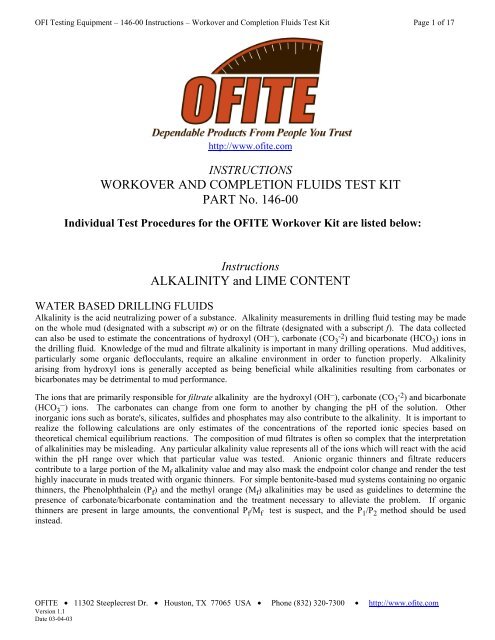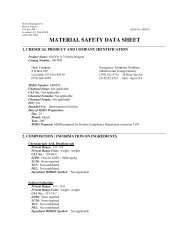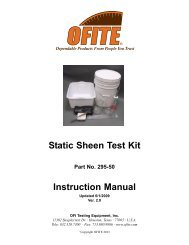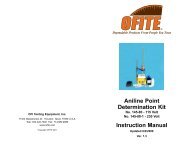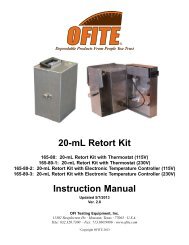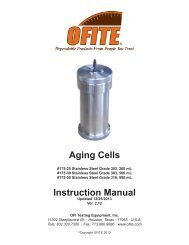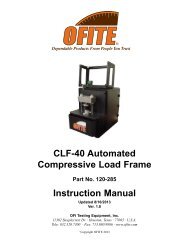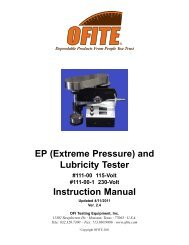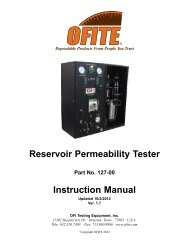Instructions - OFI Testing Equipment, Inc.
Instructions - OFI Testing Equipment, Inc.
Instructions - OFI Testing Equipment, Inc.
Create successful ePaper yourself
Turn your PDF publications into a flip-book with our unique Google optimized e-Paper software.
<strong>OFI</strong> <strong>Testing</strong> <strong>Equipment</strong> – 146-00 <strong>Instructions</strong> – Workover and Completion Fluids Test Kit Page 1 of 17<br />
http://www.ofite.com<br />
INSTRUCTIONS<br />
WORKOVER AND COMPLETION FLUIDS TEST KIT<br />
PART No. 146-00<br />
Individual Test Procedures for the <strong>OFI</strong>TE Workover Kit are listed below:<br />
<strong>Instructions</strong><br />
ALKALINITY and LIME CONTENT<br />
WATER BASED DRILLING FLUIDS<br />
Alkalinity is the acid neutralizing power of a substance. Alkalinity measurements in drilling fluid testing may be made<br />
on the whole mud (designated with a subscript m) or on the filtrate (designated with a subscript f). The data collected<br />
can also be used to estimate the concentrations of hydroxyl (OH – ), carbonate (CO 3 -2 ) and bicarbonate (HCO 3 ) ions in<br />
the drilling fluid. Knowledge of the mud and filtrate alkalinity is important in many drilling operations. Mud additives,<br />
particularly some organic deflocculants, require an alkaline environment in order to function properly. Alkalinity<br />
arising from hydroxyl ions is generally accepted as being beneficial while alkalinities resulting from carbonates or<br />
bicarbonates may be detrimental to mud performance.<br />
The ions that are primarily responsible for filtrate alkalinity are the hydroxyl (OH – ), carbonate (CO 3 -2 ) and bicarbonate<br />
(HCO 3<br />
– ) ions. The carbonates can change from one form to another by changing the pH of the solution. Other<br />
inorganic ions such as borate's, silicates, sulfides and phosphates may also contribute to the alkalinity. It is important to<br />
realize the following calculations are only estimates of the concentrations of the reported ionic species based on<br />
theoretical chemical equilibrium reactions. The composition of mud filtrates is often so complex that the interpretation<br />
of alkalinities may be misleading. Any particular alkalinity value represents all of the ions which will react with the acid<br />
within the pH range over which that particular value was tested. Anionic organic thinners and filtrate reducers<br />
contribute to a large portion of the M f alkalinity value and may also mask the endpoint color change and render the test<br />
highly inaccurate in muds treated with organic thinners. For simple bentonite-based mud systems containing no organic<br />
thinners, the Phenolphthalein (P f ) and the methyl orange (M f ) alkalinities may be used as guidelines to determine the<br />
presence of carbonate/bicarbonate contamination and the treatment necessary to alleviate the problem. If organic<br />
thinners are present in large amounts, the conventional P f /M f test is suspect, and the P 1 /P 2 method should be used<br />
instead.<br />
<strong>OFI</strong>TE • 11302 Steeplecrest Dr. • Houston, TX 77065 USA • Phone (832) 320-7300 • http://www.ofite.com<br />
Version 1.1<br />
Date 03-04-03
<strong>OFI</strong> <strong>Testing</strong> <strong>Equipment</strong> – 146-00 <strong>Instructions</strong> – Workover and Completion Fluids Test Kit Page 2 of 17<br />
<strong>Equipment</strong> - Water Based Drilling Fluids:<br />
#147-16 Pocket pH Sensor (Optional)<br />
#153-26 Titration Dish, Polyethylene<br />
#153-28 Stirring Rod, Polyethylene<br />
#153-29 Syringe, glass tip, 2 ml<br />
#153-34 Pipette, Serological, 1 ml x 1/100 ml, glass<br />
#153-40 Pipette, Serological, 10 ml x 1/10 ml, glass<br />
Reagents:<br />
#220-01 Phenolphthalein Indicator sol'n, 8 oz<br />
#230-08 Sulfuric Acid sol'n, N/50, 8 oz<br />
#240-02 Methyl Orange Indicator sol'n, 8 oz<br />
Procedure - Filtrate Alkalinity, P f, M f<br />
1. Measure one or more milliliters of filtrate into the titration dish.<br />
2. Add two or more drops of Phenolphthalein Indicator solution. If the solution turns pink, add N/50<br />
Sulfuric Acid, drop by drop from the pipette, while stirring, until the pink color just disappears. If the<br />
filtrate is so colored that the end point cannot be seen, use a pH meter and titrate until the pH of the<br />
solution drops to pH 8.3, and this will be the end point.<br />
3. Report the Phenolphthalein Alkalinity of the filtrate, P f , as the number of milliliters of N/50 Sulfuric Acid<br />
required per milliliters of filtrate.<br />
4. To the same sample which was titrated to the P f endpoint, add two or three drops of Methyl Orange Indicator<br />
solution. Add the N/50 Sulfuric Acid drop by drop from the pipette while stirring until the color of the indicator<br />
changes from yellow to pink. The end point may also be taken when the pH of the sample drops to pH 4.3 as<br />
measured with a pH meter (more accurate).<br />
5. Report the Methyl Orange Alkalinity of the filtrate, M f , as the total milliliters of N/50 Sulfuric Acid per<br />
milliliters of filtrate required to reach the Methyl-Orange end-point. This also includes the amount of acid used<br />
to reach the Phenolphthalein, P f , end-point.<br />
Calculation, P f , M f (Estimation of Hydroxide (OH – ), Carbonate (CO 3<br />
–2 ) & Bicarbonate (HCO3 – ) ions)<br />
Test Results<br />
Calculation, Concentration mg/liter<br />
P f = 0 M f x 1220 = mg/L HCO 3<br />
– (Indicates Bicarbonate ion only)<br />
P f = M f P f x 340 = mg/L OH – (Indicates Hydroxide ion only)<br />
2P f < M f 2P f x 600 = mg/L CO 3<br />
–2 (Indicates Carbonate ion)<br />
(M f – 2P f ) x 1220 = mg/L HCO 3<br />
– (Indicates Bicarbonate ion)<br />
2P f = M f M f x 600 = mg/L CO 3<br />
–2 (Indicates Carbonate ion only)<br />
2P f > M f (2P f – M f ) x 340 = mg/L OH – (Indicates Hydroxide ion)<br />
(M f – P f ) x 1200 = mg/L CO 3<br />
–2 (Indicates Carbonate ion)<br />
<strong>OFI</strong>TE • 11302 Steeplecrest Dr. • Houston, TX 77065 USA • Phone (832) 320-7300 • http://www.ofite.com<br />
Version 1.1<br />
Date 03-04-03
<strong>OFI</strong> <strong>Testing</strong> <strong>Equipment</strong> – 146-00 <strong>Instructions</strong> – Workover and Completion Fluids Test Kit Page 3 of 17<br />
Procedure - Whole Mud Alkalinity, P m<br />
1. Measure 1 ml of drilling mud into the titration dish and dilute with 25 to 50 ml of distilled water.<br />
2. Add four or five drops of Phenolphthalein Indicator solution and while stirring, titrate with N/50 Sulfuric acid<br />
solution until the pink color just disappears. If the end point color change cannot be seen, it can be taken when<br />
the pH drops to pH 8.3 as measured on a pH meter. If cement contamination is suspected, the titration must be<br />
performed as rapidly as possible and the end-point is reported as the first disappearance of the pink color.<br />
3. Report the Phenolphthalein alkalinity of the whole mud, P m , as the number of milliliters of N/50 Sulfuric acid<br />
required per milliliter of mud.<br />
Procedure - Lime Content, Estimated<br />
1. Determine the P f and P m of the filtrate and whole mud as described in the Alkalinity test.<br />
2. Determine the volume fraction of water F w , using the percent of water from the liquid and solids as<br />
determined in a Retort analysis.<br />
F w = % Water by Volume<br />
100<br />
3. Report the Lime Content of the Fluid:<br />
Alternate Alkalinity Procedure<br />
Estimated Lime, lb/bbl = 0.26 (P m - F w x P f )<br />
Estimated Lime, kg/m 3 = 0.742 (P m - F w x P f )<br />
The P1/P2 Back Titration method is used to overcome some limitations of the P f /M f alkalinity method. A serious<br />
problem arises with anionic organic thinners, filtrate reducers and their degradation products which may contribute to a<br />
large portion of the alkalinity value, as well as masking the end point color change. These organic materials make a<br />
particularly large contribution to the M f alkalinity and thus render the test highly inaccurate in treated with organic<br />
thinners. If organic thinners are present in large amounts, the P1/P2 method should be used, but it also has its<br />
limitations. See the table below:<br />
Method Advantages Disadvantages<br />
P f /M f Traditional Method Interference with the M f titration<br />
2 Titrations, 1 Sample Bicarbonate result normally too high<br />
P1/P2 Eliminates interference 3 Titrations with 3 samples<br />
in M f titrations<br />
Caustic measurement critical<br />
Uses a toxic material - BaCl 2<br />
<strong>OFI</strong>TE • 11302 Steeplecrest Dr. • Houston, TX 77065 USA • Phone (832) 320-7300 • http://www.ofite.com<br />
Version 1.1<br />
Date 03-04-03
<strong>OFI</strong> <strong>Testing</strong> <strong>Equipment</strong> – 146-00 <strong>Instructions</strong> – Workover and Completion Fluids Test Kit Page 4 of 17<br />
<strong>Equipment</strong> - P1/P2 Alkalinity Method<br />
#147-16 Pocket pH Meter (Optional)<br />
#147-54 pH paper strips, range 7 - 14 pH<br />
#153-16 Graduate Cylinder, 25 ml x 2/10 ml, glass<br />
#153-18 Graduate Cylinder, 10 ml x 2/10 ml, glass<br />
#153-20 Graduate Cylinder, 5 ml x 1/10 ml, glass<br />
#153-26 Titration Dish, polyethylene<br />
#153-34 Pipette, 1 ml x 1/100 ml, glass<br />
#153-36 Pipette, 2 ml x 1/100 ml, glass<br />
#168-05 Stirring Rod, polyethylene<br />
Reagents:<br />
#206-02 Distilled Water, 16 oz<br />
#220-00 Phenolphthalein Indicator sol'n, 2 oz<br />
#260-01 Sodium Hydroxide sol'n, 16 oz<br />
#275-04 Hydrochloric Acid sol'n, 0.02N, 8 oz<br />
#285-07 Barium Chloride, 10 % sol'n, 8 oz<br />
Procedure - P1/P2 Alkalinity<br />
1. Determine the P f alkalinity as described above.<br />
2. Measure and add 1.0 ml of Filtrate to the titration dish, then add 25 ml of distilled water.<br />
3. Using a pipette add 2.0 ml of Sodium Hydroxide, 0.1N and stir well.<br />
4. Measure the pH of the solution with the pH paper or the pH meter.<br />
If the pH is 11.4 or greater proceed to the next step.<br />
If the pH is less than 11.4 add 2.0 ml more of 0.1N Sodium Hydroxide solution and then proceed. Exact<br />
measurements of Sodium Hydroxide is necessary to avoid serious errors.<br />
5. Using the 5 ml Graduate Cylinder, measure 3 ml of Barium Chloride and add to the titration dish.<br />
Caution: Do not use your mouth to pipette Barium Chloride as it is extremely poisonous.<br />
6. Add 2 to 4 drops of Phenolphthalein Indicator solution while stirring.<br />
7. Immediately titrate the mixture with the standard 0.02 normal Hydrochloric Acid to the first disappearance of<br />
the pink color - or to a pH of 8.3 with a pH meter. The color may reappear after a short time but do not continue<br />
the titration.<br />
8. Report the Alternate Alkalinity, P1, as the total ml of 0.02 normal Hydrochloric acid required to reach the<br />
phenolphthalein end point.<br />
9. Determine the Blank Alkalinity, P2. Omit the Filtrate, but repeat the above procedure from item 1 through 8 for<br />
determining the P1. Use exactly the same quantities of water and reagents in preparing the sample.<br />
10. Report the Blank Alkalinity, P2, as the total ml of 0.02 normal Hydrochloric acid required to titrate the<br />
reagent mixture to the phenolphthalein end point.<br />
<strong>OFI</strong>TE • 11302 Steeplecrest Dr. • Houston, TX 77065 USA • Phone (832) 320-7300 • http://www.ofite.com<br />
Version 1.1<br />
Date 03-04-03
<strong>OFI</strong> <strong>Testing</strong> <strong>Equipment</strong> – 146-00 <strong>Instructions</strong> – Workover and Completion Fluids Test Kit Page 5 of 17<br />
Calculation - P1/P2 Alkalinity Method<br />
When P1 > P2:<br />
When P1 < P2:<br />
OH – , mg/L = 340 (P1 – P2)<br />
CO 3<br />
–2 , mg/L = 1200 [Pf – (P1–P2)]<br />
HCO 3<br />
– , mg/L = 1220 (P2 – P1)<br />
CO 3<br />
-2 , mg/L = 1200 Pf<br />
WHOLE MUD ALKALINITY - OIL BASED DRILLING FLUID<br />
Procedure:<br />
1. Add 100 ml of Arcosolv PNP solvent to the 400 ml beaker<br />
2. Fill the 5 ml syringe with at least 3 ml of whole mud and discharge 2 ml into the beaker. Swirl the<br />
mixture until it is homogenous.<br />
3. Add 200 ml of distilled water.<br />
4. Add 15 drops of Phenolphthalein Indicator solution.<br />
5. While stirring with the magnetic stirrer, slowly titrate with N/10 Sulfuric Acid until the pink color just<br />
disappears. Continue stirring for one more minute, and if no pink color reappears, discontinue stirring. It may<br />
be necessary to stop the stirring to allow separation of the two phases in order to more clearly see the color in<br />
the aqueous phase.<br />
6. Let the sample stand for 5 minutes and if no pink color reappears, the Alkalinity end point has been reached. If<br />
the pink color returns, titrate a second time with the Sulfuric Acid solution. If the pink color still returns<br />
titrate a third time, but if the color returns after this third titration, call this the end point.<br />
7. Use the total ml of N/10 Sulfuric acid solution required to reach the end point to calculate the whole mud<br />
Alkalinity, V sa .<br />
Calculation:<br />
Alkalinity (Whole Mud), V sa =<br />
N/10 Sulfuric Acid, ml<br />
Mud Sample, ml<br />
<strong>OFI</strong>TE • 11302 Steeplecrest Dr. • Houston, TX 77065 USA • Phone (832) 320-7300 • http://www.ofite.com<br />
Version 1.1<br />
Date 03-04-03
<strong>OFI</strong> <strong>Testing</strong> <strong>Equipment</strong> – 146-00 <strong>Instructions</strong> – Workover and Completion Fluids Test Kit Page 6 of 17<br />
TOTAL HARDNESS TITRATION<br />
(Calcium and Magnesium)<br />
Kit Part No. 145-10<br />
INSTRUCTIONS:<br />
This test measures the amount of soluble calcium and magnesium ions in a mud filtrate. When measured<br />
simultaneously, the result is called total hardness. The calcium ion concentration can be determined separately and<br />
when it is subtracted from the total hardness, the magnesium ion concentration can then be determined. Different<br />
buffer-indicator combinations may be used for these determinations. It is imperative however not to intermix the<br />
various buffers and indicators.<br />
Procedure:<br />
Components:<br />
#153-26 Titration Dish, polyethylene<br />
#153-28 Stirring Rod, polyethylene<br />
#153-34 Pipette, glass, 1 ml x 1/100 ml<br />
#153-40 Pipette, glass, 10 ml x 1/10 ml<br />
Reagents:<br />
#205-02 Indicator sol’n, (Calmagite), Versenate Hardness, 2 oz<br />
#205-04 *Buffer sol’n., (Ammonium), 2 oz (UN2672)<br />
#205-06 Titration sol’n., (EDTA), 40 mg/L, 2 EPM, 8 oz<br />
#205-10 Titration sol’n., (EDTA), 400 mg/L, 20 EPM, 8 oz<br />
#206-02 Deionized Water, 16 oz<br />
• Hazardous Chemical – Must be specially packaged, and hazardous shipping charges will apply.<br />
1. Add 50 mls of deionized water to a titration dish.<br />
2. Add 20 to 40 drops (1 – 2 mls) of hardness buffer solution to the dish.<br />
3. Add 10 to 15 drops (0.5 – 0.75 mls) of hardness indicator solution to the mixture.<br />
4. If a wine-red to a purple color develops, the deionized water used in step 1, contains hardness. If there is a<br />
color change, add total hardness titrating solution drop wise while stirring until the water turns to a bright<br />
blue color.<br />
5. Using the pipette, add 1 ml of filtrate into the titration dish and stir. A wine red to purple color will again<br />
develop if calcium and/or magnesium is present in the filtrate solution.<br />
6. Add total hardness titrating solution, stirring continuously, until the sample again turns a bright blue color.<br />
Calculation:<br />
<strong>OFI</strong>TE • 11302 Steeplecrest Dr. • Houston, TX 77065 USA • Phone (832) 320-7300 • http://www.ofite.com<br />
Version 1.1<br />
Date 03-04-03
<strong>OFI</strong> <strong>Testing</strong> <strong>Equipment</strong> – 146-00 <strong>Instructions</strong> – Workover and Completion Fluids Test Kit Page 7 of 17<br />
epm Calcium and Magnesium = mls of Hardness Titrating solution used x 2<br />
(If the solution strength is 1 ml = 2 epm Hardness)<br />
epm Calcium and Magnesium = mls of Hardness Titrating solution used x 20<br />
(If the solution strength is 1 ml = 20 epm Hardness)<br />
Usually the magnesium ion content is negligible, so the total Hardness is reported as being all Calcium.<br />
Therefore:<br />
mg/L Calcium = epm Total Hardness x 20<br />
More or less sample can be used to obtain a titration between 1 and 10 mls, in which case the results obtained above<br />
should be divided by the ml of sample used.<br />
epm = equivalent parts per million<br />
Sometimes the test is erratic at low temperatures due to the change in solubility of the ingredients.<br />
If desired, separate test may be performed for Calcium and Magnesium individually using Calcium Buffer<br />
solution and Calver II Indicator powder. See separate instructions.<br />
Various Buffer Indicator Combinations:<br />
1. Versenate Buffer solution (#205-04, Ammonium Hydroxide, pH = 12 –13) with Versenate Indicator (#205-02,<br />
Calmagite).<br />
2. Manver Indicator (#205-27) with Ammonium Hydroxide Buffer (#205-04, pH = 12 –13)<br />
3. Eriochrome Black T indicator (#205-28) with Ammonium Hydroxide Buffer<br />
(#205-04 pH = 12 –13)<br />
Water Based Drilling Fluids<br />
All of these combinations may be used to determine Total Hardness.<br />
CALCIUM ANALYSIS<br />
INSTRUCTIONS<br />
When Hardness Titration solution (EDTA) is added to water or mud filtrate that contains both Calcium and Magnesium,<br />
the EDTA first combines with the Calcium. Calcium alone can be determined with EDTA when the pH of the sample is<br />
sufficiently high so that magnesium is precipitated out as the Hydroxide, and an indicator specific to Calcium is used.<br />
Several indicators will give color changes when all of the Calcium has been complexed by the EDTA at a pH in the<br />
range of 12 to 13. An end point obscured by dark organic components may be treated by oxidizing with Sodium<br />
Hypochlorite.<br />
<strong>Equipment</strong>:<br />
#153-14 Graduated Cylinder, 50 ml x 1.0 ml, glass<br />
#153-34 Pipette, 1.0 ml x 1/100 ml, glass<br />
<strong>OFI</strong>TE • 11302 Steeplecrest Dr. • Houston, TX 77065 USA • Phone (832) 320-7300 • http://www.ofite.com<br />
Version 1.1<br />
Date 03-04-03
<strong>OFI</strong> <strong>Testing</strong> <strong>Equipment</strong> – 146-00 <strong>Instructions</strong> – Workover and Completion Fluids Test Kit Page 8 of 17<br />
#153-36 Pipette, 2.0 ml x 1/10 ml, glass<br />
#153-38 Pipette, 5.0 ml x 1/10 ml, glass<br />
#153-40 Pipette, 10.0 ml x 1/10 ml, glass<br />
#153-51 Beaker, 250 ml, glass<br />
#168-01 Hot Plate, with Thermostat, 115 volt (Optional)<br />
(Required if the filtrate is colored)<br />
or<br />
#168-01-1 Hot Plate, with Thermostat, 230 volt (Optional)<br />
Reagents:<br />
#205-12 Titration sol'n (EDTA), Ver. Hard., 0.01M, 400 Mg/L, 16 oz<br />
#205-14 Calcium Buffer sol'n (NaOH), 1N, 2 oz<br />
#206-02 Deionized Water, 16 oz<br />
#210-00 Calver ® II Indicator Powder, 10 gram<br />
#230-25 Acetic Acid, Glacial, 8 oz (UN2789) (Optional)<br />
#261-00 Sodium Hypochlorite sol'n, 8 oz (UN1791) (Optional)<br />
#261-50 Masking Agent, 1:1:2 mixture by volume of<br />
Triethanolamine: Tetraethylenepentamine : Water, 16 oz<br />
(Optional)<br />
Procedure:<br />
WORK IN AN ADEQUATELY VENTILATED AREA.<br />
1. Using a pipette add at least 1.0 mL of sample to the Beaker. This volume will be used in the calculation<br />
formula below.<br />
If the filtrate is colorless or is only slightly colored, omit steps 2 - 5.<br />
2. Add 10.0 ml of Sodium Hypochlorite solution and mix.<br />
3. Add 1.0 ml of Glacial Acetic Acid and mix.<br />
4. Boil the sample for 5 minutes and maintain the sample volume by adding deionized water as required during<br />
boiling. Boiling removes excess Chlorine and this may be verified by immersing a strip of pH paper in the<br />
sample. If the paper is bleached white, continue boiling. A sufficiently boiled sample will have a pH of 5.0.<br />
5. Cool the sample and wash the sides of the beaker with deionized water.<br />
6. Using deionized water, dilute the sample to approximately 50 ml.<br />
7. Add 10 to 15 ml of Calcium Buffer solution, or sufficient Buffer solution to produce a pH of 12 - 13.<br />
Note: The presence of soluble Iron may interfere with the endpoint determination. If this is suspected, a mixture of<br />
Triethanolamine: Tetraethylenepentamine: Water (1:1:2 by volume) is a suitable masking agent.<br />
Add 1 ml of the mixture at this point.<br />
8. Add sufficient Calver ® II Indicator powder (0.1 to 0.2 grams) to produce a pink to wine-red color if<br />
Calcium is present. Too much indicator will obscure the endpoint. Note: Adding several drops of<br />
Methyl Orange Indicator solution may improve the visibility of the endpoint.<br />
9. While stirring, titrate with Hardness Titration solution (EDTA), to the end point. Calcium indicators produce a<br />
Red-to-Blue change and the endpoint is best described as that point where additional Titration solution will<br />
<strong>OFI</strong>TE • 11302 Steeplecrest Dr. • Houston, TX 77065 USA • Phone (832) 320-7300 • http://www.ofite.com<br />
Version 1.1<br />
Date 03-04-03
<strong>OFI</strong> <strong>Testing</strong> <strong>Equipment</strong> – 146-00 <strong>Instructions</strong> – Workover and Completion Fluids Test Kit Page 9 of 17<br />
produce no further Red-to-Blue color change. The Titration solution volume will be used in the calculation<br />
procedure.<br />
Calculation:<br />
Calcium, mg/L = 400 (Titration sol'n, ml3 )<br />
Sample Volume, ml 3<br />
Oil Based Drilling Fluids:<br />
<strong>Equipment</strong>:<br />
#153-53 Magnetic Stirrer, with Stirring Bar<br />
#153-64 Syringe, 5 ml, disposable,<br />
#154-75 Scoop, brass, 4 inch length<br />
#297-05 Mason Jar, with Lid, 16 oz<br />
Reagents:<br />
#205-17-3 Titration sol'n. (EDTA), 4000 mg/L Ca +2 , 0.1M, 200 EPM, 16 oz<br />
#206-04 Distilled Water, gal<br />
#210-00-1 Calver ® II Indicator powder, 100 gram<br />
#260-05 Sodium Hydroxide Buffer sol'n, 1.0 N, 8 oz (UN1824)<br />
#280-30 Arcosolv PNP, gal. (UN1993)<br />
Procedure:<br />
1. Add 100 mls of Arcosolv PNP solvent to a 16 oz jar<br />
2. Fill a new 5 ml syringe with whole mud past the 3 ml mark.<br />
3. Displace 2.0 mls of oil mud into the jar with the Arcosolv solution.<br />
4. Cap the jar and shake vigorously by hand for 1 minute.<br />
5. Add 200 mls of distilled water to the jar.<br />
6. Add *6.0 mls of Sodium Hydroxide Buffer sol'n, 1 N, to the mixture.<br />
7. Add *0.7 to 1.0 gram of Calver ® II Indicator powder. (Note: 5 scoops = 0.7 grams)<br />
Recap the jar tightly and shake vigorously again for 2 minutes. Set the jar aside for a few seconds to allow the<br />
upper and lower phases to separate. If a reddish color appears in the aqueous (lower) phase, this indicates that<br />
calcium is present.<br />
8. Agitate by placing the jar on a magnetic stirrer and drop in a stirring bar.<br />
9. Titrate very slowly, adding Titration solution (EDTA) drop by drop from a pipette, while stirring only fast<br />
enough to agitate the aqueous (lower) phase without remixing the upper and lower phases. A distinct color<br />
change from the reddish color to a blue-green occurs at the end point. Note the volume of Titration solution<br />
added.<br />
10. Use the mls of titration solution required to reach the end point to calculate the whole mud calcum.<br />
Calculation:<br />
Ca oil mud = Ca, mg = 4000 (0.1 M EDTA, mls)<br />
oil mud sample, L<br />
2.0 mls<br />
*Quantities have been revised since the last API issue - "R.P. 13B-2", Third Edition, Dated Feb<br />
Water Based Fluids<br />
CHLORIDE ION KIT<br />
PART NO. 144-40<br />
<strong>OFI</strong>TE • 11302 Steeplecrest Dr. • Houston, TX 77065 USA • Phone (832) 320-7300 • http://www.ofite.com<br />
Version 1.1<br />
Date 03-04-03
<strong>OFI</strong> <strong>Testing</strong> <strong>Equipment</strong> – 146-00 <strong>Instructions</strong> – Workover and Completion Fluids Test Kit Page 10 of 17<br />
This test measures the total soluble Chloride ion concentrations in the mud Filtrate. These Chlorides can come from<br />
Sodium Chloride, Calcium Chloride or Potassium Chloride. For the titration to work correctly, the pH of the filtrate<br />
needs to be slightly basic, around pH = 8.3, etc. Two chemical reactions take place simultaneously during the titration<br />
procedure.<br />
1. Ag + + Cl¯ ——————» AgCl<br />
2. 2Ag + + CrO 4<br />
–2 ————» Ag2 CrO 4<br />
The first reaction, the formation of Silver Chloride, accounts for the appearance of the white specs or milky appearance<br />
during the titration. The formation of Silver Chromate, which is red in color, will not start until all of the Chloride Ions<br />
are tied up as Silver Chloride. The Silver Nitrate will then react with the chromate from the Potassium Chromate<br />
Indicator to form Silver Chromate. So, for the above two reactions to occur, the filtrate needs to be weakly basic. (pH =<br />
8.3). High pH will precipitate out Silver Oxide.<br />
EQUIPMENT:<br />
#153-26 Titration Dish, polyethylene<br />
#153-28 Stirring Rod, polyethylene<br />
#153-34 Pipette, 1 ml x 1/100 ml, glass<br />
#153-40 Pipette, 10 ml x 1/10 ml, glass<br />
Reagents:<br />
#206-01 Distilled Water, 8 oz<br />
#215-00 *Potassium Chromate Indicator sol'n, 2 oz (UN3082)<br />
#220-00 Phenolphthalein Indicator sol'n, 2 oz<br />
#230-08 Sulfuric Acid, 0.02N (N/50), 8 oz<br />
#265-02 Silver Nitrate sol'n, 0.001G, 0.0282N, 16 oz<br />
#265-06 Silver Nitrate sol'n, 0.01G, 0.282N, 8 oz<br />
#285-00 Calcium Carbonate, precipitated. 35 grams<br />
Case:<br />
#144-35 Multi Kit Case, Diagonal design, Stainless Steel<br />
PROCEDURE - Water Based Muds:<br />
1. Pipette one or more milliliters (cm 3 ) of filtrate into the titration dish.<br />
2. Add 2 - 3 drops of Phenolphthalein Indicator sol'n to the filtrate.<br />
If a pink color appears - Titrate with N/50 Sulfuric acid until the color is discharged.<br />
If the filtrate is deeply colored - Add an additional 2 ml of N/50 Sulfuric Acid and stir.<br />
Then add 1 gram of Calcium Carbonate and stir.<br />
3. Add 25 - 50 ml of distilled water. If any water other than distilled water is used, the chlorides in it must be<br />
accounted for by titration before adding the filtrate to it.<br />
4. Add 5 - 10 drops of Potassium Chromate Indicator sol'n.<br />
5. Add Silver Nitrate sol'n drop-by-drop from the pipette while stirring continuously with the stirring rod, until the<br />
color changes from yellow to orange-red and persists for 30 seconds. Record the number of milliliters (cm 3 ) of<br />
Silver Nitrate sol'n required to reach the end point.<br />
A. If the chloride ion concentration of the filtrate exceeds 10,000 milli grams (mg/l) per liter use the<br />
<strong>OFI</strong>TE • 11302 Steeplecrest Dr. • Houston, TX 77065 USA • Phone (832) 320-7300 • http://www.ofite.com<br />
Version 1.1<br />
Date 03-04-03
<strong>OFI</strong> <strong>Testing</strong> <strong>Equipment</strong> – 146-00 <strong>Instructions</strong> – Workover and Completion Fluids Test Kit Page 11 of 17<br />
0.1 gram chloride-ion per cubic centimeter (0.282N) strength solution.<br />
B. If over 10 milliliters (cm 3 ) of Silver Nitrate is used, repeat the test with a smaller amount of filtrate.<br />
CALCULATION:<br />
To Convert Units:<br />
Chloride, mg/L =<br />
*1000 x mls of Silver Nitrate titrated)<br />
Filtrate Sample, mls<br />
Chloride, ppm = Chloride, mg/L<br />
Specific Gravity of Filtrate<br />
Salt (NaCl), mg/L = (1.65) Chloride, mg/L<br />
* Use 1000 as the multiplier for 0.0282N (.001gram) Chloride Ion solution, and 10,000 for the 0.282N (.01 gram) AgNO 3<br />
REMARKS:<br />
1. Avoid contact with Silver Nitrate and wash immediately with water if Silver Nitrate gets on skin or<br />
clothing.<br />
2. The end point of the reaction is when the Silver Chromate is first formed and it is reddish in color. When using<br />
the weak, or 0.001 gram sol'n, the end point is approached very gradually. Therefore the formation of the Silver<br />
Chromate can be seen by a color change from yellow to orange-red. If the strong (.01gram) solution is used the<br />
end point is reached much more rapidly and may go from yellow to red. As soon as the red color is seen, the titration<br />
procedure is complete.<br />
3. White lumps of Silver Chloride form when titrating high concentrations of salt. This should not be taken for<br />
the end point of the titration.<br />
Oil Based Fluids - Whole Mud Chloride<br />
The whole mud chloride test procedure for oil muds is a titration procedure which measures the volume of a standard<br />
Silver Nitrate required to react with the Chloride ions to form insoluble Silver Chloride salts. The Chloride value<br />
reported for the whole mud may be assigned to the water phase of the solution up to the saturation point. The water<br />
soluble salt concentration indicates how effective an oil mud is in controlling shale through the "aqueous phase activity"<br />
concept. The water phase salinity value is also needed to adjust the retort value to obtain a corrected solids content for<br />
the oil mud. The test procedure uses the same sample as used in the whole mud Alkalinity test provided the sample is<br />
acidic (pH < 7).<br />
<strong>Equipment</strong> - Oil Based Fluids:<br />
#153-29-1 Syringe, glass tip, 5 ml<br />
#153-51-1 Beaker, 400 ml, glass<br />
#153-53 Magnetic Stirrer, with Stir Bars<br />
<strong>OFI</strong>TE • 11302 Steeplecrest Dr. • Houston, TX 77065 USA • Phone (832) 320-7300 • http://www.ofite.com<br />
Version 1.1<br />
Date 03-04-03
<strong>OFI</strong> <strong>Testing</strong> <strong>Equipment</strong> – 146-00 <strong>Instructions</strong> – Workover and Completion Fluids Test Kit Page 12 of 17<br />
Reagents:<br />
#206-02 Distilled Water, 16 oz<br />
#215-02 Potassium Chromate sol'n, 8 oz (UN3082)<br />
#220-01 Phenolphthalein Indicator sol'n, 8 oz<br />
#230-10 Sulfuric Acid sol'n, N/10, 8 oz<br />
#265-08 Silver Nitrate sol'n, 0.01g, 0.282N, 16 oz<br />
#280-30 Arcosolv PNP, gal.<br />
Procedure - Oil Based Fluids<br />
Perform the whole mud alkalinity test first as follows:<br />
1. Add 100 ml of Arcosolv PNP solvent to the 400 ml beaker.<br />
2. Fill the 5 ml syringe with at least 3 mls of whole mud and discharge 2 ml into the beaker. Swirl the<br />
mixture until it is homogenous.<br />
3. Add 200 ml of distilled water.<br />
4. Add 15 drops of Phenolphthalein Indicator solution.<br />
5. While stirring with the magnetic stirrer, slowly titrate with N/10 Sulfuric Acid until the pink color just<br />
disappears. Continue stirring for one more minute, and if no pink color reappears, discontinue stirring. It may<br />
be necessary to stop the stirring to allow separation of the two phases in order to more clearly see the color in<br />
the aqueous phase.<br />
6. Let the sample stand for 5 minutes and if no pink color reappears, the Alkalinity end point has been reached. If<br />
thepink color returns, titrate a second time with the Sulfuric Acid solution. If the pink color still returns titrate a<br />
third time, but if the color returns after this third titration, call this the end point.<br />
7. After running the Alkalinity test make sure the mixture to be titrated for Chlorides is acidic (pH < 7) by<br />
adding 10 - 20 drops of N/10 Sulfuric Acid.<br />
8. Add *3.0 mls of Potassium Chromate Indicator solution.<br />
9. While stirring with a Magnetic Stirrer, slowly titrate with 0.282N Silver Nitrate solution until a salmon pink<br />
color remains stable for at least one minute. It may be necessary to stop the stirring of the mixture and allow<br />
separation of the two phases to occur in order to more clearly see the color in the aqueous phase.<br />
10. Note the total milliliters of 0.282N Silver Nitrate required to reach the end point to calculate the whole mud<br />
Chloride.<br />
Calculation:<br />
Chloride, Whole Mud (Cl om ) Mg/l = 10,000 ( ml Silver Nitrate titrated)<br />
ml of sample<br />
*Quantity has been revised since the last API issue - "R.P. 13B-2", Third Edition, Dated Feb. 1998.<br />
<strong>OFI</strong>TE • 11302 Steeplecrest Dr. • Houston, TX 77065 USA • Phone (832) 320-7300 • http://www.ofite.com<br />
Version 1.1<br />
Date 03-04-03
<strong>OFI</strong> <strong>Testing</strong> <strong>Equipment</strong> – 146-00 <strong>Instructions</strong> – Workover and Completion Fluids Test Kit Page 13 of 17<br />
CALCIUM SULFATE ANALYSIS<br />
INSTRUCTIONS<br />
The Calcium Sulfate content of a drilling fluid is determined by using EDTA Titration solution to determine the total<br />
Calcium in both mud filtrate and in whole mud. The total and undissolved Calcium Sulfate content of the drilling fluid<br />
can then be calculated.<br />
<strong>Equipment</strong>:<br />
#147-53 pH paper, range 1 - 14<br />
#153-14 Cylinder, graduated, 50 ml x 1 ml, glass<br />
#153-26 Titration Dish, Polyethylene<br />
#153-34 Pipette, 1 ml x 1/100 ml, glass<br />
#153-36 Pipette, 2 ml x 1/100 ml, glass<br />
#153-38 Pipette, 5 ml x 1/10 ml, glass<br />
#153-40 Pipette, 10 ml x 1/10 ml, glass<br />
#168-01 Hot Plate, 115 volt (Required if filtrate is colored)<br />
Reagents:<br />
#205-12 Tittration solution, EDTA, 400 mg/L Ca +2 , 20 EPM, 16 oz<br />
#206-02 Distilled Water, 16 oz<br />
#210-00 Calver ® II Indicator powder, 10 gram<br />
#230-20 *Glacial Acetic Acid, 8 oz (UN2789)<br />
#260-05 *Sodium Hydroxide, 1N, 8 oz (UN1824)<br />
#261-00 Sodium Hypochlorite sol'n, 8 oz (UN1791)<br />
#261-50 Triethanolamine masking agent, 16 oz<br />
Note: Also necessary will be the following items:<br />
#140-30 Filter Press, API, full area, with CO 2 Pressuring assembly<br />
#165-00-1 Retort Kit, 10 ml, with stainless steel case, 115 volt<br />
or<br />
#165-10-1 Retort Kit, 10 ml, with stainless steel case, 220 volt<br />
Procedure:<br />
1. Add 5 ml of whole mud to 245 ml of distilled water.<br />
2. Stir the mixture for 15 minutes and filter the diluted mixture through a standard API Filter Press, collecting only<br />
clear filtrate. Also filter the undiluted whole mud through the standard API Filter Press.<br />
3. Using the 10 ml pipette, add 10 ml of the clear filtrate to the titration dish. Titrate with EDTA titration solution<br />
to the calcium endpoint, and call this volume EDTA V t. The procedure is as follows:<br />
<strong>OFI</strong>TE • 11302 Steeplecrest Dr. • Houston, TX 77065 USA • Phone (832) 320-7300 • http://www.ofite.com<br />
Version 1.1<br />
Date 03-04-03
<strong>OFI</strong> <strong>Testing</strong> <strong>Equipment</strong> – 146-00 <strong>Instructions</strong> – Workover and Completion Fluids Test Kit Page 14 of 17<br />
A. Add at least 1.0 mL of sample to the Beaker.<br />
If the filtrate is colorless or is only slightly colored, omit steps B - E.<br />
B. Add 10.0 ml of Sodium Hypochlorite solution and mix.<br />
C. Add 1.0 ml of Glacial Acetic Acid and mix.<br />
D. Boil the sample for 5 minutes and maintain the sample volume by adding distilled water as required<br />
during boiling. Boiling removes excess Chlorine and this may be verified by immersing a strip of Ph<br />
paper in the sample. If the paper is bleached white, continue boiling. A sufficiently boiled sample will<br />
have a pH of 5.0.<br />
E. Cool the sample and wash the sides of the beaker with distilled water.<br />
F. With distilled water, dilute the sample to approximately 50 ml.<br />
G. Add 10 to 15 ml of Calcium Buffer solution, or sufficient Buffer solution to produce a pH of 12 - 13.<br />
H. Optional: The presence of soluble Iron may interfere with the endpoint determination. If this is<br />
suspected, a mixture of Triethanolamine: Tetraethylenepentamine : Water (1:1:2 by volume) is a<br />
suitable masking agent.<br />
I. Add sufficient Calver ® II Indicator powder (0.1 to 0.2 grams) to produce a pink to wine-red color if<br />
Calcium is present. Too much indicator will obscure the endpoint. Note: Adding several drops of<br />
Methyl Orange Indicator solution may improve the visibility of the endpoint.<br />
J. While stirring, titrate with Hardness Titration solution (EDTA), to the end point. Calcium indicators<br />
produce a Red-to-Blue change and the endpoint is best described as that point where additional Titration<br />
solution will produce no further Red-to-Blue color change. The Titration solution volume will be used<br />
in the calculation procedure.<br />
3. Using the 1 ml pipette, add 1.0 ml of the original undiluted mud filtrate to the titration dish. Titrate with<br />
EDTA titration solution to the calcium endpoint, as above. Call this volume EDTA V f .<br />
4. Retort the whole mud. Determine the volume fraction of water in the mud by using the volume percent of water<br />
from the liquid and solids determination based upon the following equation.<br />
Volume Fraction of Water, F w =<br />
Volume Percent Water<br />
100<br />
Calculation:<br />
Total Calcium Sulfate, lb/bbl = 2.38 ( EDTA V t )<br />
The excess undissolved Calcium Sulfate content of the mud in pounds per barrel may be calculated as follows:<br />
Excess Calcium Sulfate, lb/bbl = 2.38 (EDTA V t) – 0.48 [EDTA V f x (F w )]<br />
Procedure:<br />
MAGNESIUM CONTENT<br />
The Hardness Titration test and the Calcium Titration test must be performed first.<br />
The total milliliters of Versenate Titration solution (EDTA), 1 mL = 400 mg/L Ca ++ used in the determination of total<br />
hardness, minus the milliliters of Versenate Titration solution (EDTA) used in the determination of calcium ion, times<br />
243 equals the mg/L of Magnesium.<br />
<strong>OFI</strong>TE • 11302 Steeplecrest Dr. • Houston, TX 77065 USA • Phone (832) 320-7300 • http://www.ofite.com<br />
Version 1.1<br />
Date 03-04-03
<strong>OFI</strong> <strong>Testing</strong> <strong>Equipment</strong> – 146-00 <strong>Instructions</strong> – Workover and Completion Fluids Test Kit Page 15 of 17<br />
Calculation:<br />
Mg ++ , mg/L =<br />
(mL EDTA, Total Hardness – mL EDTA, Ca++) x 243<br />
mL of Filtrate<br />
POTASSIUM & POTASSIUM CHLORIDE<br />
<strong>OFI</strong> Part No. 285-09<br />
Centrifuge Method: > 5000 Milligrams per Liter KCl (1% KCl)<br />
Potassium ion is used in drilling fluids to aid in the stabilization of shales and to control swelling clays. The accurate<br />
determination of the potassium ion content is necessary to control the properties of the drilling fluid. This procedure is<br />
used to measure the potassium ion content in mud filtrates at levels above 5000 milligrams per liter or 3.5 pounds per<br />
barrel KCl. The procedure is most accurate in the range between 10,000 mg/L (2%) and 40,000 mg/L (8%) KCl and is<br />
suspect below 10,000 mg/L (2%) KCl. Potassium is precipitated in a centrifuge tube as the perchlorate salt, and then the<br />
precipitate volume is measured. The potassium ion content is then read from a prepared standard curve.<br />
<strong>Equipment</strong>:<br />
#153-21 Centrifuge Tube, Kolmer, 10 ml (2 supplied)<br />
#153-25-2 *Centrifuge, Hand Crank, with dual head and shields<br />
#153-38 Pipette, 5 ml x 1/10 ml, glass<br />
Reagents:<br />
#206-02 Distilled Water, 16 oz<br />
#285-10 *Sodium Perchlorate sol'n, 16 oz (UN1502)<br />
#285-11 Potassium Chloride sol'n (standard), 4 oz<br />
Procedure - Generating a Standard Calibration Curve:<br />
1. A standard calibration curve is required for each type of centrifuge. A minimum of three points or test<br />
procedures (3.5, 10.5 & 17.5 pounds per barrel) is required to obtain an accurate graph.<br />
2. Samples can be prepared by using the standard potassium chloride solution where 0.5 ml of standard<br />
potassium chloride solution is equivalent to 3.5 pounds per barrel KCl.<br />
3.5 ppb KCl = 1 % KCL = 5000 mg/L ≅ 0.5 ml standard KCl solution.<br />
Therefore -<br />
A. To obtain 3.5 ppb equivalent KCl or 1% KCl use 0.5 ml of standard potassium chloride.<br />
B. To obtain 10.5 ppb equivalent KCl or 3% KCl use 1.5 ml of standard potassium chloride.<br />
C. To obtain 17.5 ppb equivalent KCl or 5% KCl use 2.5 ml of standard potassium chloride<br />
3. Dilute the samples in the centrifuge tube to the 7.0 ml mark with distilled water and agitate the mixture.<br />
4. Add 3 ml of standard sodium perchlorate solution to each centrifuge tube and do not agitate.<br />
5. Centrifuge at a constant speed of approximately 1800 revolutions per minute for one minute and read the<br />
precipitate volume immediately. It will be necessary to counterbalance the centrifuge tube with another tube<br />
and 10 ml of liquid of the same weight.<br />
A fairly constant 1800 revolutions per minute can be obtained by determining the number of revolutions of the rotor per<br />
each turn of the crank. Move the crank very slowly and count the number of revolutions of the rotor head during one turn<br />
of the crank. For example, 15 revolutions of the rotor per one turn of the crank. Calculate the number of crank turns<br />
required to obtain 1800 revolutions of the rotor head. In the example to obtain 1800 revolutions of the head would require<br />
120 turns of the crank (1800/15). Thus the crank must be turned 120 times in one minute to obtain the rate of 1800<br />
<strong>OFI</strong>TE • 11302 Steeplecrest Dr. • Houston, TX 77065 USA • Phone (832) 320-7300 • http://www.ofite.com<br />
Version 1.1<br />
Date 03-04-03
<strong>OFI</strong> <strong>Testing</strong> <strong>Equipment</strong> – 146-00 <strong>Instructions</strong> – Workover and Completion Fluids Test Kit Page 16 of 17<br />
revolutions per minute. At this rate in 5 seconds the handle must be turned 10 times (120/60) (5). By counting the crank<br />
turns in 5 seconds and adjusting the rate to obtain the required number of turns, a constant 1800 revolutions per minute<br />
should be obtained in 15 to 20 seconds. The interval used to adjust to the 1800 revolutions per minute should be included<br />
in the centrifuge time of the sample.<br />
6. Clean the centrifuge tube immediately after use to facilitate ease of cleaning.<br />
7. Plot the volume of precipitate in milliliters versus pounds per barrel of KCl or milliliters of precipitate versus<br />
percent (%) potassium chloride using rectangular graph paper as shown below.<br />
Procedure - Sample <strong>Testing</strong><br />
1. Measure the appropriate volume of filtrate into the centrifuge tube. See the table below for the volume:<br />
Filtrate Volumes to Be Used At Various KCL Concentrations<br />
Concentration<br />
Filtrate Volume<br />
Range KCl K + to use<br />
(lb/bbl (mg/L) (ml)<br />
3.5 - 18 5,250 - 27,000 7.0<br />
18 - 35 27,000 - 52,500 3.5<br />
35 - 70 52,500 - 105,000 2.0<br />
over 70 over 105,000 1.0<br />
2. Dilute to 7.0 ml if necessary with distilled water in the tube and agitate the mixture.<br />
3. Add 3.0 ml of standard sodium perchlorate solution and do not agitate. If potassium is present precipitation<br />
occurs at once.<br />
4. Centrifuge at a constant speed of approximately 1800 rpm for one minute. Read the precipitate volume<br />
immediately and then record it.<br />
5. Add 2 to 3 drops of the sodium perchlorate solution to the tube. If a precipitate still forms, the total<br />
amount of potassium has not been measured. Refer to the table above and use the next smaller filtrate<br />
volume. Repeat the procedure in items 1 - 5 above.<br />
6. Determine the potassium chloride concentration by comparing the precipitate volume measured with the<br />
standard calibration curve as prepared above. Report the potassium concentration as pounds per barrel KCl.<br />
The potassium concentration may also be reported as milligrams per liter potassium ion. If the filtrate potassium<br />
chloride concentration from the standard calibration curve exceeds an 18 pounds per barrel reading, accuracy of<br />
the results is reduced. For more accurate results, use the next smaller filtrate volume as noted in the table above,<br />
and repeat the steps 1 through 5 above.<br />
Calculation:<br />
KCl in filtrate, lb/bbl = 7 ( Value from standard curve)<br />
<strong>OFI</strong>TE • 11302 Steeplecrest Dr. • Houston, TX 77065 USA • Phone (832) 320-7300 • http://www.ofite.com<br />
Version 1.1<br />
Date 03-04-03
<strong>OFI</strong> <strong>Testing</strong> <strong>Equipment</strong> – 146-00 <strong>Instructions</strong> – Workover and Completion Fluids Test Kit Page 17 of 17<br />
filtrate used, ml<br />
K + in filtrate, mg/L = 1500 (KCl in filtrate, lb/bbl)<br />
High Potassium Chloride Concentrations<br />
If the potassium concentration of the filtrate is greater than 35,000 mg/L (7%) KCl, dilution may be accomplished as<br />
follows:<br />
1. Pipette 2.0, 3.0 or 4.0 ml of filtrate into the centrifuge tube and dilute with distilled water to the 7.0 ml mark.<br />
2. Correct the results by multiplying % KCl by 7, divided by the volume of filtrate used (2.0, 3.0 or 4.0 ml)<br />
Remarks<br />
1. The potassium ion test must be made with the same centrifuge used to construct the standard curve. Turn the<br />
centrifuge at a constant speed of 1800 rpm.<br />
2. Sodium and potassium perchlorates are explosive in the dry state if heated to a high temperature or allowed to<br />
contact organic reducing agents. The perchlorates are not hazardous if kept water wet. They will decompose<br />
harmlessly if dispersed in a bucket of water.<br />
3. Salts, lignosulfonates, polymers, clay and pH do not interfere with the test.<br />
4. The precipitate may become slightly discolored in high lignosulfonate concentrations, but the test is not<br />
adversely affected.<br />
5. Only the Kolmer-type clinical centrifuge tubes are satisfactory for the test.<br />
6. The calibration curve does not need to be remade for every potassium determination, however the validity of the<br />
curve should be rechecked regularly by re-running at least one standard.<br />
7. A new standard graph must be prepared if a different model of centrifuge is used.<br />
<strong>OFI</strong>TE • 11302 Steeplecrest Dr. • Houston, TX 77065 USA • Phone (832) 320-7300 • http://www.ofite.com<br />
Version 1.1<br />
Date 03-04-03


